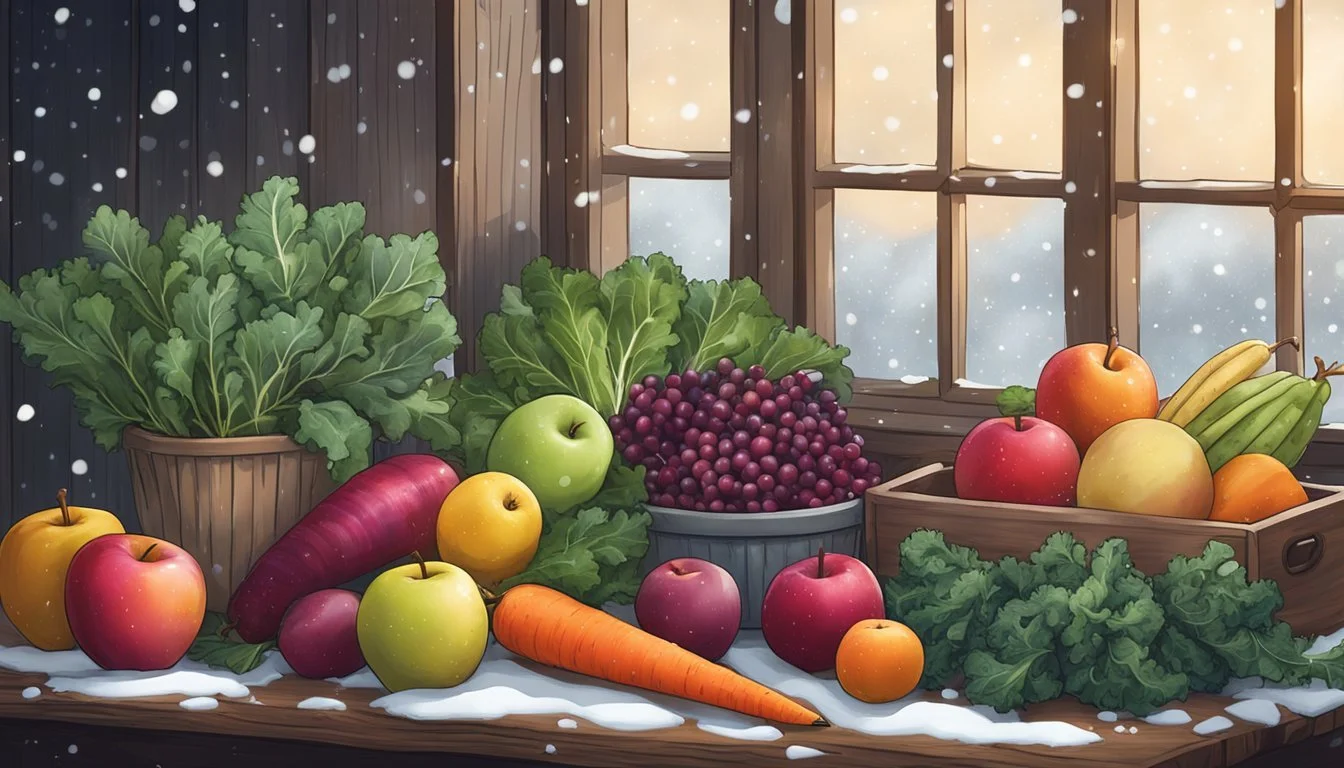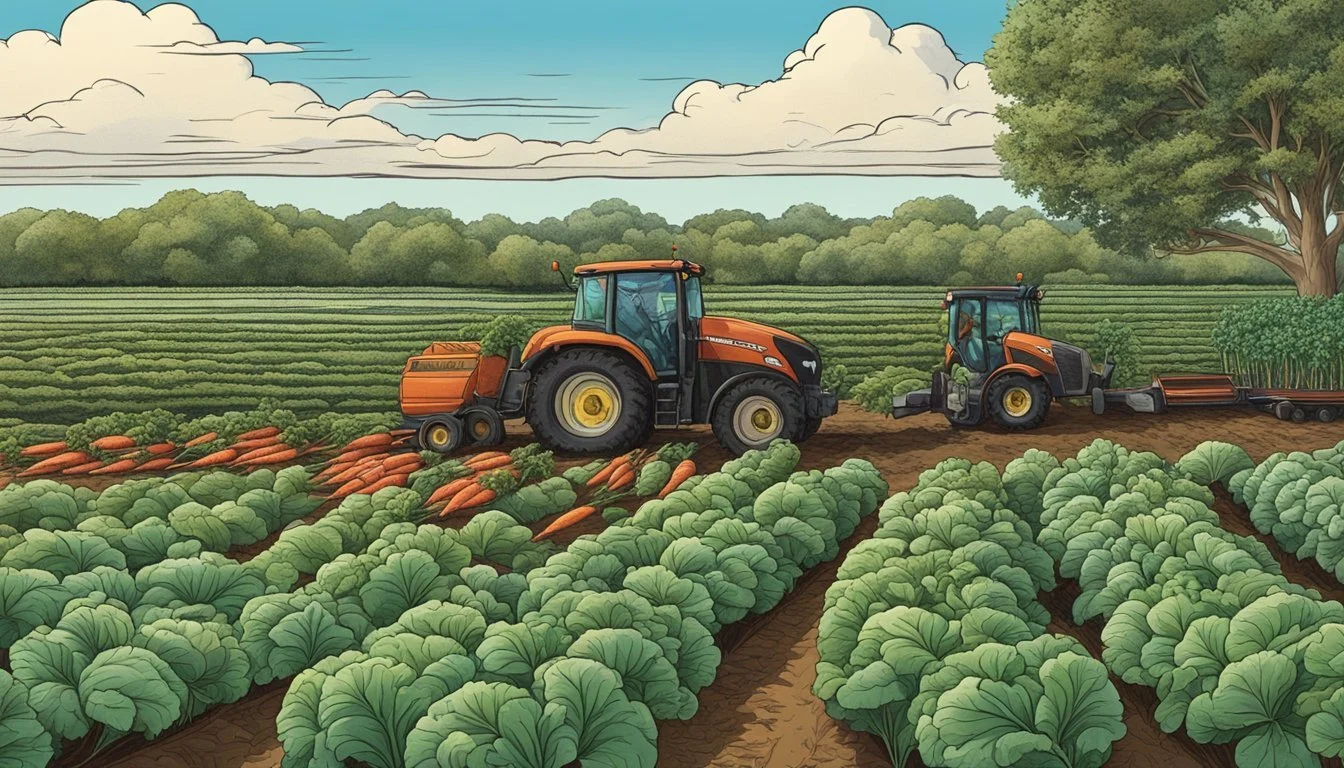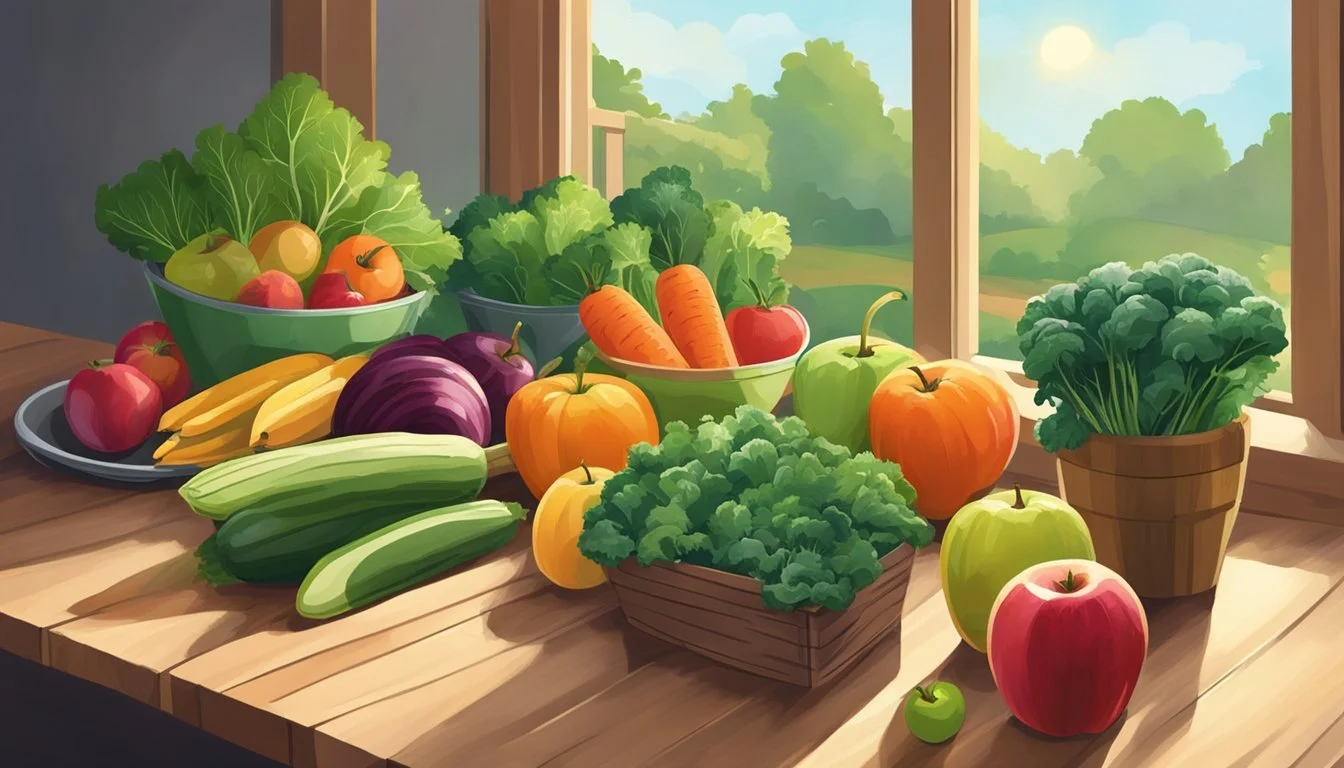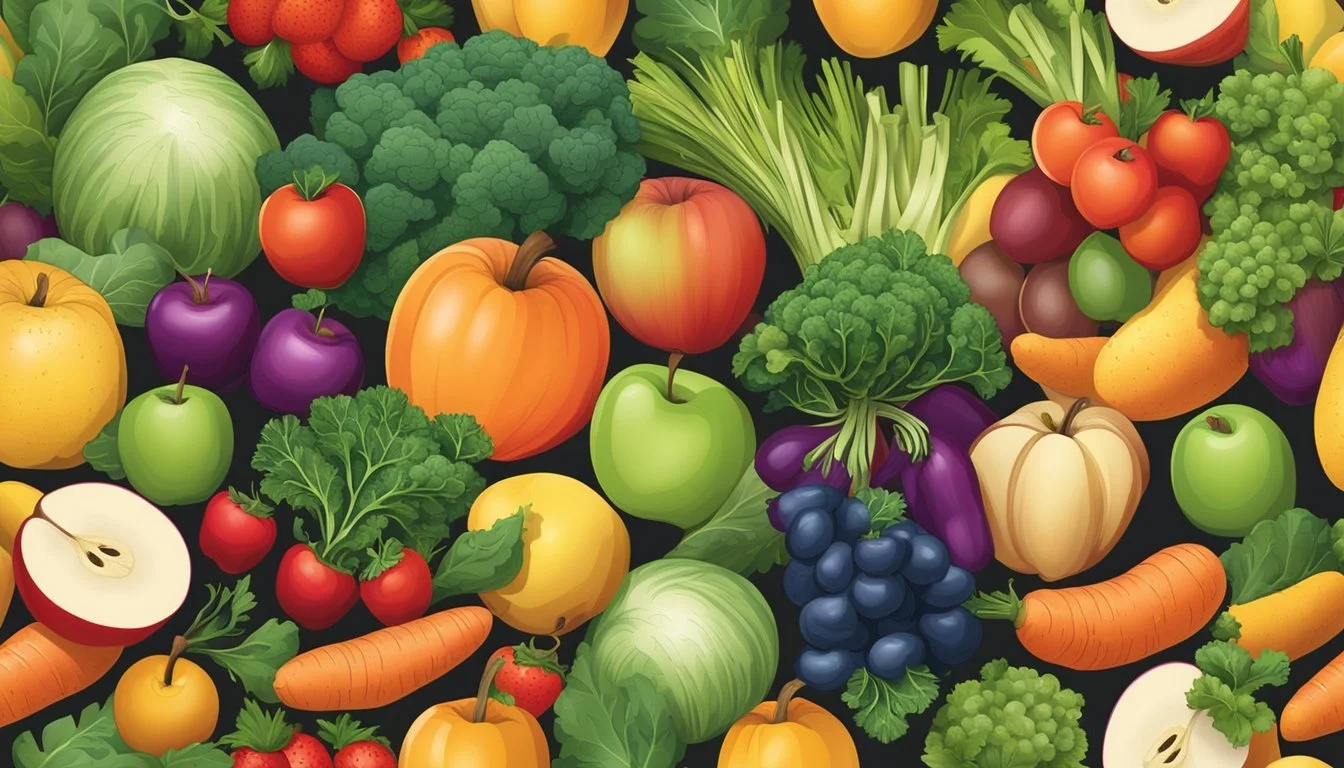Kansas Seasonal Fruit & Vegetables in January
A Guide to Fresh Produce
This Article is Part of our Kansas Seasonal Fruit & Veg Calendar
In Kansas, January is a time when the fields rest under the frost, and the variety of fresh produce is less abundant than in the bountiful summer months. However, this doesn't mean that the options for seasonal fruit (What wine goes well with fruit?) and vegetables are nonexistent. Local harvests from storage and winter-hardy crops provide Kansas residents with a selection of fresh produce even during the coldest part of the year. It's a month for robust root vegetables and some greenhouse-grown items that can withstand the chilly temperatures.
Root vegetables like turnips and sweet potatoes (What wine goes well with sweet potatoes?) are often available from storage, carrying over the fall harvest's abundance. These storage capabilities ensure that even in the depths of winter, Kansas can offer a touch of seasonal freshness on the dinner table. While fresh fruit options are generally limited during this time, the hardy storage and preservation culture in Kansas ensures that residents still have access to nutritious and flavorful ingredients.
The selection of produce available in January may not be as vast as other months, but it reinforces the resourcefulness of Kansas's agriculture. By relying on storage and strategic growing practices, Kansas manages to provide a variety of produce options. This persistence reflects the state's agricultural adaptability and commitment to providing seasonal produce throughout the year, even in the heart of winter.
Overview of Kansas's Seasonal Produce
January in Kansas falls firmly within the winter season, impacting the availability of fresh fruits and vegetables. Despite the chilly climate, consumers can still find a range of produce sourced from local growers. The focus during this time shifts to hardy root vegetables and cold storage crops that can withstand the lower temperatures.
Vegetables: Kansas's winter soil gives rise to a selection of robust vegetables. Notably, items such as sweet potatoes and various winter squashes have been harvested previously and are available thanks to proper storage. Root vegetables like carrots (how long do carrots last?), parsnips, and beets also sustain their quality during the colder months, often sweetened by the frost.
Root Vegetables: Carrots, parsnips, beets
Squashes: Winter varieties
Potatoes: Sweet varieties
Fruit: Fruit selections are decidedly sparser. However, apples from the fall harvest remain consumable due to controlled storage environments that extend their shelf life into the winter months.
Apples: Fall harvest varieties
In summary, winter in Kansas does not provide the abundance seen in warmer seasons. Still, the resilience of certain crops ensures that residents can enjoy local produce even during the colder months. While the fruit options are limited, the variety of available vegetables ensures nutritious meals can be prepared with Kansas-grown crops.
Fruit Selections in January
In Kansas, January's fruit offerings are generally limited due to the cold climate. However, consumers can still enjoy a variety of stored, imported, or greenhouse-grown fruits. Notably absent from local production this time of the year are fresh summer fruits such as berries.
Citrus fruits, sourced from warmer climates, are abundant and at peak quality during January. They offer a fresh burst of flavor and a wealth of vitamin C, which is beneficial during the winter months. Here is a selection of citrus fruits available:
Oranges: Navel, Blood, and Valencia varieties.
Grapefruits: Known for their slightly tart and bitter taste.
Lemons: Ideal for their zest and juice in various culinary uses.
Limes: Smaller and often used for their unique flavor profile.
Persimmons, although the tail end of their season, might still be found in some markets. They are cherished for their sweet, honey-like flavor when fully ripe.
Apples and pears are typically harvested in the fall but are stored efficiently, enabling their availability throughout the winter. They come in various varieties each with distinct tastes and textures, suitable for eating fresh or using in recipes.
Here is a brief list of types typically available during January:
Apples: Fuji, Gala, and Granny Smith.
Pears: Anjou, Bosc, and Comice.
Consumers should note that selection will vary, and some fruits may be imported to ensure availability. While the range of local, fresh produce might be more limited, these fruits provide opportunities for nutritious and flavorful eating during Kansas's winter season.
January Vegetable Harvest
In Kansas, January is a month where the cold weather predominates, but that doesn't hinder the growth of certain hardy vegetables. Farmers and gardeners can still harvest a selection of robust, cold-tolerant produce during this time.
Root Vegetables: Root vegetables thrive in the cooler temperatures of a Kansas January. Carrots and turnips, with their ability to stay snug underground, are generally ready to be harvested. These vegetables are known for their sweet flavors, which are often enhanced by the frosty weather.
Carrots: Sweet and crunchy, ideal for a variety of dishes.
Turnips: Typically harvested, can be utilized for both their roots and greens.
Leafy Greens: Leafy greens like kale (What wine goes well with kale?) and lettuce are remarkably resilient. They can survive the frost, which often makes their leaves even more flavorful.
Kale: Known for its nutritional value and versatile use in winter dishes.
Lettuce: Different varieties can be harvested for fresh salads.
Brassicas: This group of plants includes vegetables such as broccoli, which can handle the cold weather.
Broccoli: Can be harvested, known for its hearty florets and high vitamin content.
Alliums: Garlic, sown earlier in the year, is dormant now but continues to develop under the soil, ready for a later harvest.
Garlic: Not typically harvested until the warmer months, still grows slowly beneath the surface.
Gourds and Squashes: Winter squashes are usually harvested before January, having been planted in the previous growing season. They store well and are available throughout the winter months.
Winter Squash: Not harvested in January but can be found in storage and consumed throughout the winter season.
Cruciferous Vegetables: Radishes are another crop that may be available in January, depending on the weather and if they've been protected from harsh conditions.
Radishes: Some varieties might be harvested; they are quick-growing and add a peppery kick to dishes.
Indoor Grown Produce
January in Kansas presents limitations for outdoor gardening due to cold weather conditions. However, gardeners can foster a thriving indoor garden that produces a variety of edible plants. Indoor gardening allows for year-round cultivation of herbs, mushrooms, green onions, and scallions, which do not require the traditional outdoor space and soil.
Herbs are particularly suited for indoor growth due to their compact size and low maintenance requirements. A windowsill with sufficient sunlight can be an ideal spot for pots of basil, mint, and parsley. These herbs can be harvested regularly to provide fresh flavors for meals.
Basil
Mint
Parsley
Mushrooms can also thrive indoors as they do not rely on sunlight and can grow in controlled environments with kits specifically designed for home use. These fungi are a gourmet addition to any dish, and their indoor cultivation ensures a fresh supply.
Mushroom Kits: Ideal for indoor conditions
For enthusiasts looking to grow alliums, green onions and scallions are excellent options. They can be grown in jars of water or small pots with soil. By snipping the greens, one encourages continuous regrowth, providing a steady supply for culinary use.
Green Onions & Scallions: Easy regrowth in water or soil
By maintaining proper indoor temperatures and ensuring adequate light exposure, these plants can be grown successfully within the confines of one's home. The control over the growing environment also mitigates common outdoor gardening challenges, such as pests and extreme weather.
Storing Your January Produce
In Kansas, maintaining the quality of January's seasonal produce begins with proper storage techniques. Whether one has harvested their own vegetables or purchased them, here are straightforward storage guidelines tailored specifically for commonly available January crops.
Citrus Fruits (Lemons, Limes):
Store in a cool, well-ventilated place.
They can be kept at room temperature for a week or refrigerated to extend shelf life up to several weeks.
Root Vegetables (Beets, Carrots):
Remove any tops to prevent moisture loss.
Place in a plastic bag with holes and store in the refrigerator's crisper drawer.
Leafy Greens (Kale, Spinach):
Wrap in a damp paper towel and place in a perforated plastic bag.
Refrigerate to maintain freshness.
Cruciferous Vegetables (Broccoli (how long does broccoli last?), Cauliflower):
Store loose in the crisper drawer or in a loosely tied plastic bag.
Refrigerate and consume within a week for optimal freshness.
Storage Table for Kansas January Produce:
Produce Storage Location Shelf Life Citrus Fruits Refrigerator/Cool area 1-3 weeks Root Vegetables Refrigerator's crisper drawer 2-4 weeks Leafy Greens Refrigerator wrapped in damp towel 3-5 days Cruciferous Vegetables Refrigerator's crisper drawer Up to 1 week
By adhering to these storage recommendations, individuals in Kansas can ensure their January produce remains fresh and nutritious, maximizing the benefits of the state's seasonal bounty.
Farmers Markets and Availability
In Kansas, the winter month of January offers a more limited selection of fresh produce at local farmers markets compared to the bountiful harvests available in the warmer months. However, consumers can still access quality fruits and vegetables, mainly through storage crops and hearty winter varieties that are able to withstand the colder temperatures.
Seasonal Availability:
While many of the summer and fall crops have finished their season, Kansas farmers markets may offer a range of storage root vegetables and some greenhouse-grown produce.
Root Vegetables:
Turnips
Potatoes
Sweet potatoes
Carrots
Greens:
These may be available from greenhouse growers.Spinach
Kale
Apples:
May still be available from cold storage in various varieties.
Market Operations:
Many farmers markets in Kansas alter their schedules during the winter months. Some may operate on reduced hours or move to indoor venues to continue providing local produce to communities. Shoppers may find that fewer vendors are present, yet those who are in attendance provide a selection of goods that represent the resilience and adaptability of Kansas agriculture.
Supporting Local Economy:
Patronizing farmers markets during January encourages the local economy and supports small family businesses. It further ensures that even in the colder months, there is a demand for local, fresh produce, reinforcing the agricultural community of Kansas.
It is recommended for consumers to check with specific markets for their January hours and available produce beforehand, as these can vary from location to location.
Health Benefits of Seasonal Eatin
Eating seasonally can bring a multitude of health benefits. Seasonal produce in Kansas during January often includes hearty vegetables that can withstand the cooler temperatures. Individuals incorporating these local selections into their diet receive optimal nutritional value as fruits and vegetables picked at their peak of ripeness contain more vitamins and minerals.
Nutritious value is paramount in seasonal eating. For example, winter produce such as sweet potatoes and Brussels sprouts (how long do brussels sprouts last?) found in Kansas are not only rich in dietary fiber but also in essential nutrients that bolster overall health. Sweet potatoes provide a high level of vitamin A, which is crucial for maintaining healthy skin and vision, while Brussels sprouts offer vitamin C and vitamin K.
Including a variety of Kansas seasonal produce ensures a diet replete with different nutrients, which can enhance bodily functions and support the immune system. Consuming a diverse range of vegetables can also aid in reducing inflammation, a key benefit during the harsher winter months.
Here are some nutritious Kansas winter produce picks and their benefits:
Sweet Potatoes: High in beta-carotene, helping to maintain skin health and vision.
Brussels Sprouts: Loaded with antioxidants and fibers, supporting digestive health.
Seasonal eating also supports local farming communities and can reduce the carbon footprint associated with transporting non-local produce. It connects consumers with the rhythm of nature, contributing to a more sustainable lifestyle while offering the freshest possible ingredients for their meals.









